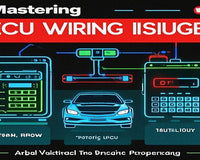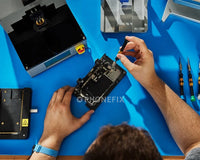Car ECU chip is the core of your vehicle’s engine management system. It processes data from sensors to adjust fuel injection, ignition timing, and other critical engine functions. A faulty chip can cause poor performance, stalling, or even prevent your car from starting. If you suspect your car’s ECU or its internal ECU chip is malfunctioning, you might be wondering if you can diagnose it yourself without a trip to the mechanic. While professional tools and expertise are sometimes necessary, there are several DIY methods to help you.
DIY Testing Methods for Your ECU Chip.
1. Check for Common Symptoms First
A malfunctioning ECU chip often reveals itself through distinct symptoms. Start by noting these red flags:
Random engine misfires.
Sudden drops in fuel efficiency with no other obvious cause.
Rough idle or stalling.
Persistent check engine light.
Starting problems, such as long cranking without ignition.
If multiple symptoms appear together, it increases the likelihood of an ECU chip issue—since the chip coordinates so many systems.
2. Use V519 OBD-II Scanner to Read Codes.
Most modern cars have an OBD-II port (usually under the dashboard). While codes rarely say “bad ECU” directly, multiple codes for unrelated sensors failing at once may indicate the ECU chip is misinterpreting data.
Monitor live data: XTOOL D6S OBD2 scanners can show real-time sensor readings, such as engine temp, fuel pressure. Compare these to your car’s factory specs. Erratic or impossible values suggest the ECU chip is faulty.
3. Visual Inspection of the ECU.
The ECU itself (often located in the engine bay, under the dash, or in the trunk) can show physical signs of a bad chip: burnt or melted components, corrosion on connectors and cracked solder joint.
4. Test the ECU’s Power Supply.
Use a multimeter to check voltage at the ECU’s electrical connector. Most ECUs require 12V and 5V. If readings are off, check fuses, wiring, or the alternator. If power is normal but problems persist, the issue is more likely with the ECU chip itself.
5. Swap the ECU.
If you have a spare known-good ECU (same make, model, and year), swapping it is a definitive test: disconnect the battery, remove your old ECU, and install the spare. Reconnect the battery and start the car. If issues vanish, your original ECU (and its chip) is likely bad.
DIY methods can help identify basic issues like power supply or ground problems, but sophisticated testing requires diagnostic equipment and expertise. The full testing and verification are best to call professionals.
Professionals are use specialized tools to run the ECU through diagnostic programs, checking the chip’s ability to process inputs. A faulty chip may fail to retain settings, which requires advanced equipment to detect.
Your car’s “brain” is critical—don’t ignore signs of a failing ECU chip! Keep in mind that a functional ECU is important for optimal car performance, so take action at the first sign of trouble to avoid more complex and costly repairs down the line.
DIY Methods to Test Your ECU Chip At Home










